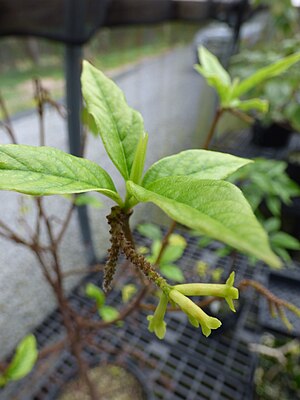Wikstroemia villosa
| Wikstroemia villosa | ||||||||||||
|---|---|---|---|---|---|---|---|---|---|---|---|---|

Wikstroemia villosa |
||||||||||||
| Systematics | ||||||||||||
|
||||||||||||
| Scientific name | ||||||||||||
| Wikstroemia villosa | ||||||||||||
| Hillebr. |
Wikstroemia villosa (English name: Hairy Wikstroemia ) is an extremely rare species of plant from the family of the daphne family (Thymelaeaceae). It is endemic to the island of Maui ( Hawaii ).
description
Wikstroemia villosa is a shrub or small tree and reaches a height of 3 to 4.5 meters. The broadly elliptical to elliptical-egg-shaped leaves are usually eight to thirteen inches long and three to four inches wide. The leaves are shaggy and hairy, but sometimes smooth. The middle main axis of the pinnate leaf ( rachis ) is 5 to 25 millimeters long.
The flower stalks are two to four millimeters long. The flowers are yellow. The fruits are elliptical, ten to thirteen millimeters long and about seven millimeters in diameter.
status
Wikstroemia villosa was collected several times on the northern slope of Haleakalā on East Maui. There were two other collections on the ridges of the Wailuku Valley on West Maui. After a documented sighting from 1928, the species was considered lost for a long time until a single specimen was rediscovered in 2007. Wikstroemia villosa grows in the rainforests of the mountain regions. Parts of the habitat were converted into pastures for cattle. Feral domestic pigs and competition from invasive plants pose a further threat .
literature
- Warren L. Wagner, Derral R. Herbst, SH Sohmer: Manual of the Flowering Plants of Hawai'i . University of Hawai'i Press, 1999
- Carl Skottsberg: The genus Wikstroemia Endl. in the Hawaiian Islands . Acta Regiae Soc. Sci. Suffered. Gothob, 1972
Web links
- Wikstroemia villosa in the endangered Red List species the IUCN 2006. Posted by: World Conservation Monitoring Center, 1998. Accessed June 2 of 2007.
- Entry at Natureserve
Individual evidence
- ^ Hank Oppenheimer: New Hawaiian plant records for 2009. Records of the Hawaii Biological Survey for 2009-2010. Edited by Neal L. Evenhuis & Lucius G. Eldredge. Bishop Occasional Papers 110: p. 5-10. 2011